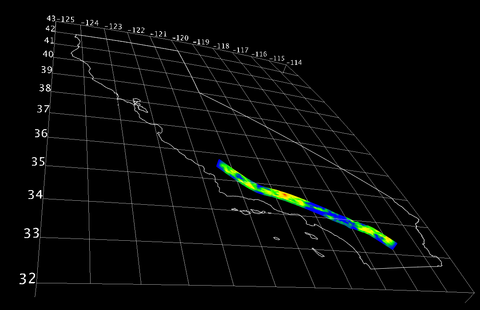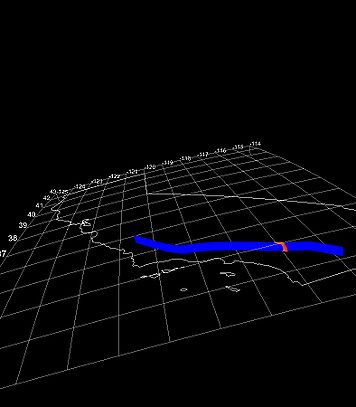Difference between revisions of "CyberShake"
| Line 1: | Line 1: | ||
CyberShake is a SCEC research Project that is working to develop a physics-based computational approach to probabilistic seismic hazard analysis (PSHA). The CyberShake approach uses full 3D wave propagation simulations to forecast ground motions that will be produced by specific ruptures which is expected to produced significantly more accurate estimates for many sites than commonly used empirical-based ground motion decay attenuation relationships. | CyberShake is a SCEC research Project that is working to develop a physics-based computational approach to probabilistic seismic hazard analysis (PSHA). The CyberShake approach uses full 3D wave propagation simulations to forecast ground motions that will be produced by specific ruptures which is expected to produced significantly more accurate estimates for many sites than commonly used empirical-based ground motion decay attenuation relationships. | ||
| + | |||
| + | == Project Summary == | ||
| + | |||
| + | SCEC’s CyberShake Project utilizes 3D simulations and finite-fault rupture descriptions to compute deterministic (scenario-based) and probabilistic seismic hazard in Southern California. Computational demands are intense, requiring parallel algorithms and high throughput workflows. Long period effects such as coupling of directivity and basin response that cannot be captured with standard approaches are clearly evident in the recently completed CyberShake 1.0 hazard map. Moreover, CyberShake allows for rapid recomputation of the hazard map to reflect short-term probability variations provided by operational earthquake forecasting. Going beyond traditional hazard analysis, event-specific phenomena can also be identified and analyzed through examination of the individual ground motion waveforms. This process highlights the importance of key elements in the Earthquake Rupture Forecast that are required by the simulation approach, including magnitude-rupture area scaling, aleatory and epistemic magnitude variability and spatio-temporal rupture characterization. | ||
| + | |||
| + | == Related Entries == | ||
| + | |||
| + | * [[UCVM]] | ||
| + | |||
| + | == References == | ||
| + | |||
| + | #The SCEC CyberShake Project: A Computational Platform for Full Waveform Seismic Hazard Analysis | ||
| + | Robert Graves (USGS), Scott Callaghan (USC), Patrick Small (USC), Gaurang Mehta (USC), Kevin Milner (USC), Gideon Juve (USC), Karan Vahi (USC), Edward Field (USGS), Ewa Deelman (USC/ISI), David Okaya (USC), Philip Maechling (USC), Thomas H. Jordan (USC) | ||
CyberShake represents significant research at SCEC and additional information will be posted on this wiki as time permits. | CyberShake represents significant research at SCEC and additional information will be posted on this wiki as time permits. | ||
Revision as of 06:48, 19 February 2011
CyberShake is a SCEC research Project that is working to develop a physics-based computational approach to probabilistic seismic hazard analysis (PSHA). The CyberShake approach uses full 3D wave propagation simulations to forecast ground motions that will be produced by specific ruptures which is expected to produced significantly more accurate estimates for many sites than commonly used empirical-based ground motion decay attenuation relationships.
Contents
Project Summary
SCEC’s CyberShake Project utilizes 3D simulations and finite-fault rupture descriptions to compute deterministic (scenario-based) and probabilistic seismic hazard in Southern California. Computational demands are intense, requiring parallel algorithms and high throughput workflows. Long period effects such as coupling of directivity and basin response that cannot be captured with standard approaches are clearly evident in the recently completed CyberShake 1.0 hazard map. Moreover, CyberShake allows for rapid recomputation of the hazard map to reflect short-term probability variations provided by operational earthquake forecasting. Going beyond traditional hazard analysis, event-specific phenomena can also be identified and analyzed through examination of the individual ground motion waveforms. This process highlights the importance of key elements in the Earthquake Rupture Forecast that are required by the simulation approach, including magnitude-rupture area scaling, aleatory and epistemic magnitude variability and spatio-temporal rupture characterization.
Related Entries
References
- The SCEC CyberShake Project: A Computational Platform for Full Waveform Seismic Hazard Analysis
Robert Graves (USGS), Scott Callaghan (USC), Patrick Small (USC), Gaurang Mehta (USC), Kevin Milner (USC), Gideon Juve (USC), Karan Vahi (USC), Edward Field (USGS), Ewa Deelman (USC/ISI), David Okaya (USC), Philip Maechling (USC), Thomas H. Jordan (USC)
CyberShake represents significant research at SCEC and additional information will be posted on this wiki as time permits.
All these numbers are without optimizations (other than AWP-ODC)
Southern California, 0.5 Hz (current functionality)
Sites: 223 sites (802 on 5 km grid)
Jobs: 190 million
CPU-hours: 5.5 million (Ranger)
Data products (seismograms, spectral acceleration): 2.1 TB
Runtime on half-Ranger: 174 hrs (7.3 days)
Runtime on half-Jaguar: 40 hrs (1.7 days)
Runtime on half-BW(=half-Mira): 10 hrs
Database entries: 366 million
Southern California, 1.0 Hz
AWP-ODC
Sites: 223 sites
Jobs: 190 million
CPU-hours: 19.3 million (Ranger)
Data products (seismograms, spectral acceleration): 4.0 TB
Runtime on half-Ranger: 613 hrs (25.5 days)
Runtime on half-Jaguar: 142 hrs (5.9 days)
Runtime on half-BW(=half-Mira): 35 hrs (1.5 days)
Database entries: 366 million
California, 0.5 Hz
Current software
Sites: 4240
Jobs: 3.6 billion
CPU-hours: 104.6 million (Ranger)
Data products (seismograms, spectral acceleration): 39.9 TB
Runtime on half-Ranger: 3322 hrs (138.4 days)
Runtime on half-Jaguar: 771 hrs (32.2 days)
Runtime on half-BW(=half-Mira): 192 hrs (8 days)
Database entries: 6.95 billion
With AWP-ODC
Sites: 4240
Jobs: 3.6 billion
CPU-hours: 83.5 million (Ranger)
Data products (seismograms, spectral acceleration): 39.9 TB
Runtime on half-Ranger: 2652 hrs (110.5 days)
Runtime on half-Jaguar: 616 hrs (25.7 days)
Runtime on half-BW(=half-Mira): 153 hrs (6.4 days)
Database entries: 6.95 billion
California, 1.0 Hz
AWP-ODC
Jobs: 3.6 billion
CPU-hours: 376.2 million (337.8 million - SGT generation only, 339.1 million - SGT workflow)
Data products (seismograms, spectral acceleration): 76.5 TB
Runtime on half-Ranger: 11947 hrs (497.8 days)
Runtime on half-Jaguar: 3096 hrs (129 days)
Runtime on half-BW(=half-Mira): 770 hrs (32.1 days) (4.3% of yearly CPU-hrs)
Database entries: 6.95 billion
Related Work
One of the requirements for the 2010 USEIT intern class was to create a Standard Rupture Format (SRF) browser plugin for SCEC-VDO. This required a tool to retrieve SRF files from the CyberShake database. The 'GETCSSRF' web service was written to allow users to retrieve the SRF files from the CyberShake database.
This web service was written as a Python web.py application. The service takes a set of arguments to select the desired file out of the CyberShake database and returns the contents of the SRF file is found. The service also supports an option to list the set of supported CyberShake Earthquake Rupture Forecast and Rupture Variation Scenario versions.
Fig 1. is a snapshot of the SCEC-VDO SRF Browser Plugin displaying a SRF file retrieved with the 'GETCSSRF' service from the CyberShake Database.
A video tutorial of the SRF browser plugin and the underlying SRF retrieval web service in action created by the USEIT interns can be found here: SRF Browser Plugin Tutorial

